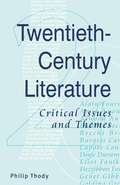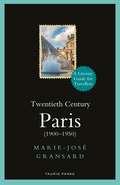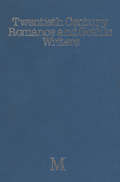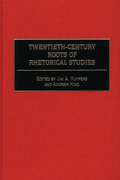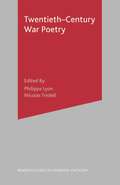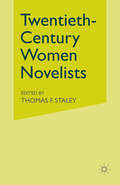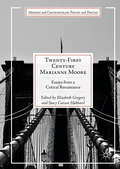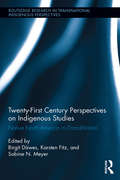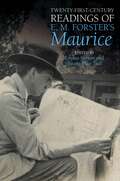- Table View
- List View
Twentieth-Century Literature: Critical Issues and Themes
by Philip ThodyBy studying the nature of disbelief, the treatment of childhood, the presentation of moral and political problems, the taste for experimentation and the greater liberty now available for the description of sexual experiences, this introduction to twentieth-century literature seeks to define what distinguishes the literature of the twentieth century from that of the periods preceding it. Particular attention is given to the problem of realism, especially in the context of the 'magical realism' practised by European as well as non-European authors.
Twentieth Century Paris: 1900-1950: A Literary Guide for Travellers (Literary Guides for Travellers)
by Marie-José GransardParis at the turn of the twentieth century had become the cultural capital of the world. Artists and writers came to contribute to flourishing avant-garde movements, as the Left Bank became a new centre of creativity. It drew tourists and travellers, but also many exiled from their home countries or escaping political persecution, and those seeking freedom from social constraints. The romantic myth of Paris persists, but Marie-José Gransard explores the darker side of the City of Light. She brings her subjects to life by describing where and how they lived, what they wrote and what was written about them, through a wide-ranging literary legacy of diaries, memoirs, letters, poetry, theatre, cinema and fiction. In Twentieth-Century Paris: a Literary Guide for Travellers (1900-1950) both the visitor and the armchair traveller alike will find familiar names, from Ernest Hemingway and George Orwell to Virginia Woolf and Katherine Mansfield, and they will encounter unfairly forgotten or neglected writers, artists and musicians; famous and less well-known Russians, and thinkers from as far as the Caribbean and Latin America.
Twentieth-Century Poetic Translation: Literary Cultures in Italian and English
by Daniela Caselli Daniela La PennaTwentieth Century Poetic Translation analyses translations of Italian and English poetry and their roles in shaping national identities by merging historical, cultural and theoretical perspectives. Focusing on specific case studies within the Italian, English and North American literary communities, spanning from 'authoritative' translations of poets by poets to the role of dialect poetry and anthologies of poetry, the book looks at the role of translation in the development of poetic languages and in the construction of poetic canons. It brings together leading scholars in the history of the Italian language, literary historians and translators, specialists in theory of translation and history of publishing to explore the cultural dynamics between poetic traditions in Italian and English in the twentieth century.
Twentieth-Century Roots of Rhetorical Studies
by Jim A. Kuypers Andrew KingKuypers, King, and their contributors explore the conception of rhetoric of eleven key American rhetoricians through analyses of their life's work. Each chapter provides a sense of that scholar's conception of rhetoric, be it through criticism, theory, or teaching. The communication discipline often highlights the work of others outside the discipline; however, it rarely acclaims the work of its own critics, teachers, and theorists. In this collection, the essays explore the innate mode of perception that guided the rhetorical understanding of the early critics. In so doing, this work dispels the myth that the discipline of Speech Communication was spawned from a monolithic and rigid center that came to be called neo-Aristotelianism. Scholars and researchers involved with the history of rhetoric, rhetorical criticism and theory, and American public address uill find this title to be a necessary addition to their collection.
Twentieth-Century Russian Poetry: Reinventing The Canon
by Katharine Hodgson Joanne Shelton Alexandra SmithThe canon of Russian poetry has been reshaped since the fall of the Soviet Union. A multi-authored study of changing cultural memory and identity, this revisionary work charts Russia’s shifting relationship to its own literature in the face of social upheaval. Literary canon and national identity are inextricably tied together, the composition of a canon being the attempt to single out those literary works that best express a nation’s culture. This process is, of course, fluid and subject to significant shifts, particularly at times of epochal change. This volume explores changes in the canon of twentieth-century Russian poetry from the 1991 collapse of the Soviet Union to the end of Putin’s second term as Russian President in 2008. In the wake of major institutional changes, such as the abolition of state censorship and the introduction of a market economy, the way was open for wholesale reinterpretation of twentieth-century poets such as Iosif Brodskii, Anna Akhmatova and Osip Mandel′shtam, their works and their lives. In the last twenty years many critics have discussed the possibility of various coexisting canons rooted in official and non-official literature and suggested replacing the term "Soviet literature" with a new definition – "Russian literature of the Soviet period". Contributions to this volume explore the multiple factors involved in reshaping the canon, understood as a body of literary texts given exemplary or representative status as "classics". Among factors which may influence the composition of the canon are educational institutions, competing views of scholars and critics, including figures outside Russia, and the self-canonising activity of poets themselves. Canon revision further reflects contemporary concerns with the destabilising effects of emigration and the internet, and the desire to reconnect with pre-revolutionary cultural traditions through a narrative of the past which foregrounds continuity. Despite persistent nostalgic yearnings in some quarters for a single canon, the current situation is defiantly diverse, balancing both the Soviet literary tradition and the parallel contemporaneous literary worlds of the emigration and the underground. Required reading for students, teachers and lovers of Russian literature, Twentieth-Century Russian Poetry brings our understanding of post-Soviet Russia up to date.
Twentieth-Century War Poetry: A Reader's Guide To Essential Criticism (Readers' Guides to Essential Criticism)
by Philippa LyonPoets have written about wars throughout the twentieth century - questioning, protesting and, sometimes, celebrating the nature and purpose of conflict. Attracting an enthusiastic popular readership, war poetry has often been seen as a way of remembering and re-imagining wars. Today, war poems are not only part of our memorial culture, on epitaphs and in Remembrance Day services, but have inspired books and films and become studied widely around the world.This Guide examines the genesis and development of the important genre of war poetry in the twentieth century, focusing in particular on the role of the two world wars in the literary and cultural construction of a 'war poetry' category. Philippa Lyon draws upon a range of key historical and contemporary critical responses, from poetic memoir and journalism to sophisticated academic criticism, to demonstrate the rich diversity of expectations and evaluations elicited by the developing genre.
Twentieth-Century War Poetry (Readers' Guides to Essential Criticism)
by Philippa LyonPoets have written about wars throughout the 20th century - questioning, protesting and, sometimes, celebrating the nature and purpose of conflict. Attracting an enthusiastic popular readership, war poetry has often been seen as a way of remembering and re-imagining wars. Today, war poems are not only part of our memorial culture, on epitaphs and in Remembrance Day services, but have inspired books and films and become studied widely around the world.This Guide examines the genesis and development of the important genre of war poetry in the twentieth century, focusing in particular on the role of the two world wars in the literary and cultural construction of a 'war poetry' category. Philippa Lyon draws upon a range of key historical and contemporary critical responses, from poetic memoir and journalism to sophisticated academic criticism, to demonstrate the rich diversity of expectations and evaluations elicited by the developing genre.
Twenty-First Century Arab and African Diasporas in Spain, Portugal and Latin America (Routledge Studies in Latin American and Iberian Literature)
by Cristián H. RicciThis volume considers the Arabic and African Diasporas through the underexplored Afro-Hispanic, Luso-Africans, and Mahjari (South American and Mexican authors of Arab descent) experiences in Spain, Portugal, and Latin America. Utilizing both established and emerging approaches, the authors explore the ways in which individual writers and artists negotiate the geographical, cultural, and historical parameters of their own diasporic trajectories influenced by their particular locations at home and elsewhere. At the same time, this volume sheds light on issues related to Spain, Portugal, and Latin American racial, ethnic, and sexual boundaries; the appeal of images of the Middle East and Africa in the contemporary marketplace; and the role of Spanish, Portuguese and Latin American economic crunches in shaping attitudes towards immigration. This collection of thought-provoking essays extends the concepts of diaspora and transnationalism, forcing the reader to reassess their present limitations as interpretive tools. In the process, Afro-Hispanic, Afro-Portuguese, and Mahjaris are rendered visible as national actors and transnational citizens.
Twenty-First Century Arab and African Diasporas in Spain, Portugal and Latin America (Routledge Studies in Latin American and Iberian Literature)
by Cristián H. RicciThis volume considers the Arabic and African Diasporas through the underexplored Afro-Hispanic, Luso-Africans, and Mahjari (South American and Mexican authors of Arab descent) experiences in Spain, Portugal, and Latin America. Utilizing both established and emerging approaches, the authors explore the ways in which individual writers and artists negotiate the geographical, cultural, and historical parameters of their own diasporic trajectories influenced by their particular locations at home and elsewhere. At the same time, this volume sheds light on issues related to Spain, Portugal, and Latin American racial, ethnic, and sexual boundaries; the appeal of images of the Middle East and Africa in the contemporary marketplace; and the role of Spanish, Portuguese and Latin American economic crunches in shaping attitudes towards immigration. This collection of thought-provoking essays extends the concepts of diaspora and transnationalism, forcing the reader to reassess their present limitations as interpretive tools. In the process, Afro-Hispanic, Afro-Portuguese, and Mahjaris are rendered visible as national actors and transnational citizens.
Twenty-First-Century Children’s Gothic: From the Wanderer to Nomadic Subject (PDF)
by Chloé Germaine BuckleyThis is the first monograph that brings together the fields of Gothic Studies and children’s fiction to analyse a range of popular and literary works for children published since 2000. It offers a completely new way of reading children’s Gothic that counters the dominant critical positions in both Gothic Studies and children’s literature criticism. This book contends that the Gothic, as it is repurposed in children’s fiction, is a creative force through which to imagine positive self-transformation. It rejects the pedagogical model of children’s literature criticism, which analyses and assess works based on what or how they teach the child, and instead draws on the theories of Deleuze and Guattari, Rosi Braidotti and Benedict Spinoza to develop the theme of ‘nomadic subjectivity’. The book covers texts from popular culture, novels by much-neglected female writers, as well as more celebrated works: Frances Hardinge’s The Lie Tree, Neil Gaiman’s Coraline, Darren Shan’s Zom-B, Jamila Gavin’s Coram Boy, Paula Morris’s Ruined, Derek Landy’s Skulduggery Pleasant, Anthony Horowitz’s The Power of Five; as well as films such as Frankenweenie and Paranorman. This broad scope allows for clear demonstration of the broad relevance of nomadic subjectivity for children’s literature criticism.
Twenty-First-Century Children’s Gothic: From the Wanderer to Nomadic Subject
by Chloé Germaine BuckleyBrings Ben Jonson to the twenty-first century by reading Volpone through psychoanalysis, poststructuralism and Marxism
Twenty-first-century fiction: Contemporary British voices
by Daniel LeaThis book offers readings of five of the most interesting and original voices to have emerged in Britain since the millennium as they tackle the challenges of portraying the new century. Through close readings of the work of Ali Smith, Andrew O'Hagan, Tom McCarthy, Sarah Hall and Jon McGregor, Daniel Lea opens a window onto the formal and thematic concerns that characterise a literary landscape troubled by both familiar and unfamiliar predicaments. These include questions about the meaning of humanness in an age of digital intercourse; about the need for a return to authenticity in the wake of postmodernism; and about the dislocation of self from the other under neoliberal individualism. By relating its readings of these authors to the wider shifts in contemporary literary criticism, this book offers in-depth analysis of important landmarks of recent fiction and an introduction to the challenges of understanding the literature of our time.
Twenty-first-century fiction: Contemporary British voices
by Daniel LeaThis book offers readings of five of the most interesting and original voices to have emerged in Britain since the millennium as they tackle the challenges of portraying the new century. Through close readings of the work of Ali Smith, Andrew O'Hagan, Tom McCarthy, Sarah Hall and Jon McGregor, Daniel Lea opens a window onto the formal and thematic concerns that characterise a literary landscape troubled by both familiar and unfamiliar predicaments. These include questions about the meaning of humanness in an age of digital intercourse; about the need for a return to authenticity in the wake of postmodernism; and about the dislocation of self from the other under neoliberal individualism. By relating its readings of these authors to the wider shifts in contemporary literary criticism, this book offers in-depth analysis of important landmarks of recent fiction and an introduction to the challenges of understanding the literature of our time.
Twenty-First Century Fiction: What Happens Now
by Siân Adiseshiah and Rupert HildyardThis lively new volume of essays examines what happens now in 21st century fiction. Fresh theoretical approaches to writers such as Salman Rushdie, David Peace, Margaret Atwood, and Hilary Mantel, and identifications of 21st-century themes, tropes and styles combine to produce a timely critical intervention into genuinely contemporary fiction.
Twenty-first-century Fiction (PDF): A Critical Introduction
by Peter BoxallThe widespread use of electronic communication at the dawn of the twenty-first century has created a global context for our interactions, transforming the ways we relate to the world and to one another. This critical introduction reads the fiction of the past decade as a response to our contemporary predicament - one that draws on new cultural and technological developments to challenge established notions of democracy, humanity, and national and global sovereignty. Peter Boxall traces formal and thematic similarities in the novels of contemporary writers including Don DeLillo, Margaret Atwood, J. M. Coetzee, Marilynne Robinson, Cormac McCarthy, W. G. Sebald and Philip Roth, as well as David Mitchell, Chimamanda Ngozi Adichie, Dave Eggers, Ali Smith, Amy Waldman and Roberto Bolaño. In doing so, Boxall maps new territory for scholars, students and interested readers of today's literature by exploring how these authors narrate shared cultural life in the new century.
Twenty-First Century Marianne Moore: Essays from a Critical Renaissance
by Elizabeth Gregory Stacy Carson HubbardThis collection represents a new range of critical awareness and marks the burgeoning of what is a twenty-first-century Marianne Moore renaissance. The essays explore Moore’s participation in modernist movements and communities, her impact on subsequent generations of artists, and the dynamics of her largely disregarded post-World War II career. At the same time, they track the intersection of the evolution of her poetics with cultural politics across her career. Drawing on fresh perspectives from previously unknown biographical material and new editions and archives of Moore’s work, the essays offer particularly interesting insights on Moore’s relationships and her late career role as a culture icon.
Twenty-First Century Marianne Moore: Essays from a Critical Renaissance
by Elizabeth Gregory Stacy Carson HubbardThis collection represents a new range of critical awareness and marks the burgeoning of what is a twenty-first-century Marianne Moore renaissance. The essays explore Moore’s participation in modernist movements and communities, her impact on subsequent generations of artists, and the dynamics of her largely disregarded post-World War II career. At the same time, they track the intersection of the evolution of her poetics with cultural politics across her career. Drawing on fresh perspectives from previously unknown biographical material and new editions and archives of Moore’s work, the essays offer particularly interesting insights on Moore’s relationships and her late career role as a culture icon.
Twenty-First Century Perspectives on Indigenous Studies: Native North America in (Trans)Motion (Routledge Research in Transnational Indigenous Perspectives)
by Sabine N. Meyer Birgit Däwes Karsten FitzIn recent years, the interdisciplinary fields of Native North American and Indigenous Studies have reflected, at times even foreshadowed and initiated, many of the influential theoretical discussions in the humanities after the "transnational turn." Global trends of identity politics, performativity, cultural performance and ethics, comparative and revisionist historiography, ecological responsibility and education, as well as issues of social justice have shaped and been shaped by discussions in Native American and Indigenous Studies. This volume brings together distinguished perspectives on these topics by the Native scholars and writers Gerald Vizenor (Anishinaabe), Diane Glancy (Cherokee), and Tomson Highway (Cree), as well as non-Native authorities, such as Chadwick Allen, Hartmut Lutz, and Helmbrecht Breinig. Contributions look at various moments in the cultural history of Native North America—from earthmounds via the Catholic appropriation of a Mohawk saint to the debates about Makah whaling rights—as well as at a diverse spectrum of literary, performative, and visual works of art by John Ross, John Ridge, Elias Boudinot, Emily Pauline Johnson, Leslie Marmon Silko, Emma Lee Warrior, Louise Erdrich, N. Scott Momaday, Stephen Graham Jones, and Gerald Vizenor, among others. In doing so, the selected contributions identify new and recurrent methodological challenges, outline future paths for scholarly inquiry, and explore the intersections between Indigenous Studies and contemporary Literary and Cultural Studies at large.
Twenty-First Century Perspectives on Indigenous Studies: Native North America in (Trans)Motion (Routledge Research in Transnational Indigenous Perspectives #1)
by Sabine N. Meyer Birgit Däwes Karsten FitzIn recent years, the interdisciplinary fields of Native North American and Indigenous Studies have reflected, at times even foreshadowed and initiated, many of the influential theoretical discussions in the humanities after the "transnational turn." Global trends of identity politics, performativity, cultural performance and ethics, comparative and revisionist historiography, ecological responsibility and education, as well as issues of social justice have shaped and been shaped by discussions in Native American and Indigenous Studies. This volume brings together distinguished perspectives on these topics by the Native scholars and writers Gerald Vizenor (Anishinaabe), Diane Glancy (Cherokee), and Tomson Highway (Cree), as well as non-Native authorities, such as Chadwick Allen, Hartmut Lutz, and Helmbrecht Breinig. Contributions look at various moments in the cultural history of Native North America—from earthmounds via the Catholic appropriation of a Mohawk saint to the debates about Makah whaling rights—as well as at a diverse spectrum of literary, performative, and visual works of art by John Ross, John Ridge, Elias Boudinot, Emily Pauline Johnson, Leslie Marmon Silko, Emma Lee Warrior, Louise Erdrich, N. Scott Momaday, Stephen Graham Jones, and Gerald Vizenor, among others. In doing so, the selected contributions identify new and recurrent methodological challenges, outline future paths for scholarly inquiry, and explore the intersections between Indigenous Studies and contemporary Literary and Cultural Studies at large.
Twenty-First-Century Readings of E. M. Forster's 'Maurice' (Liverpool English Texts and Studies #83)
This is the first book-length study of Forster’s posthumously-published novel. Nine essays focus exclusively on Maurice and its dynamic afterlives in literature, film and new media during the twentieth and twenty-first centuries. Begun in 1913 and revised over almost fifty years, Maurice became a defining text in Forster’s work and a canonical example of queer fiction. Yet the critical tendency to read Maurice primarily as a ‘revelation’ of Forster’s homosexuality has obscured important biographical, political and aesthetic contexts for this novel. This collection places Maurice among early twentieth-century debates about politics, philosophy, religion, gender, Aestheticism and allegory. Essays explore how the novel interacts with literary predecessors and contemporaries including John Bunyan, Oscar Wilde, Havelock Ellis and Edward Carpenter, and how it was shaped by personal relationships such as Forster’s friendship with Florence Barger. They close-read the textual variants of Forster’s manuscripts and examine the novel’s genesis and revisions. They consider the volatility of its reception, analysing how it galvanizes subsequent generations of writers and artists including Christopher Isherwood, Alan Hollinghurst, Damon Galgut, James Ivory and twenty-first-century online fanfiction writers. What emerges from the volume is the complexity of the novel, as a text and as a cultural phenomenon.
Twenty-First Century Readings of ‘Tender is the Night’
by William Blazek Laura RattrayBringing together established Fitzgerald scholars from the United Kingdom, Europe and North America, this collection offers eleven new readings of F. Scott Fitzgerald’s 1934 novel, Tender is the Night. While The Great Gatsby continues to attract more attention than the rest of Fitzgerald’s oeuvre combined, persistent, if infrequent, writings on Tender is the Night from the 1950s onwards indicate that, like Gatsby’s green light, Fitzgerald’s fourth novel continues both to perplex and intrigue. In addition to the inevitable biographical interpretations, the novel has, in myriad readings, been viewed as: a marriage novel, a text of disturbed psychology, a text nostalgically marking the passing of a talent and a time, an outdated “Jazz Age” story, and “the great novel about American history”. This new collection of essays opens criticism of Tender Is the Night to a new generation of scholars providing new ways for readers to appreciate this complex, compelling, and profound work.Contributors include editors of the F. Scott Fitzgerald Review, the general editor of the Cambridge Edition of Writings of F. Scott Fitzgerald, members of the Fitzgerald Society Executive, and the directors of the biennial F. Scott Fitzgerald conference. The book will be published to coincide with the biennial F. Scott Fitzgerald conference in July 2007.
Twenty-First-Century Symbolism: Verlaine, Baudelaire, Mallarmé (Contemporary French and Francophone Cultures #83)
by Nikolaj LübeckerHow do the writings of Verlaine, Baudelaire, and Mallarmé speak to our time? Why should we continue to read these poets today? How might a contemporary reading of their poetry differ from readings delivered in previous centuries? Twenty-First-Century Symbolism argues that Verlaine, Baudelaire, and Mallarmé prefigure a view of human subjectivity that is appropriate for our times: we cannot be separated from the worlds in which we live and evolve; human beings both mediate and are mediations of the environments we traverse and that traverse us, whether these are natural, urban, linguistic, or technological environments. The ambition of the book is therefore twofold: on the one hand, it aims to offer new readings of the three poets, demonstrating their continued relevance for contemporary debates, putting them into dialogue with a philosophical corpus that has not yet played a role in the study of nineteenth century French poetry; on the other, the book relies on the three poets to establish an understanding of human subjectivity that is in tune with our twenty-first century concerns.
